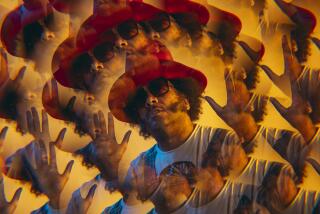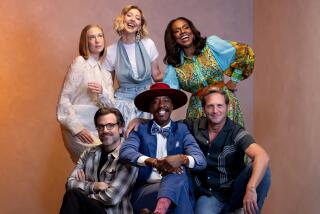Charles Nelson Reilly, 76; Tony-winning actor, TV game show regular
- Share via
Charles Nelson Reilly, whose persona as a wacky game show panelist and talk show guest overshadowed his serious work as a director and Tony-winning actor, has died. He was 76.
Reilly, a longtime resident of Beverly Hills, died Friday of complications from pneumonia at UCLA Medical Center, said Paul Linke, who directed Reilly’s one-man show “Save It for the Stage: The Life of Reilly.”
“The average person thinks of him as being on ‘The Match Game.’ That was a mixed blessing for him,” Linke told The Times on Monday. “One of the reasons I was so motivated to get his show out there was because I wanted people to recognize that this was a heavyweight talent.”
When a Times reporter visited his home in 2000, Reilly displayed an opera review that referred to him as “Charles Nelson Reilly of ‘Hollywood Squares’ fame.”
“It’s like a scarlet letter,” Reilly yowled in his high-pitched, nasal voice.
Wearing his trademark ascot and oversized glasses, Reilly made a near-record 97 appearances on “The Tonight Show Starring Johnny Carson,” often making ribald ripostes.
After a “Tonight Show” guest who was talking about Shakespeare dismissed Reilly’s attempt to join the conversation, he silenced her by delivering Hamlet’s “the play’s the thing” monologue straight, with depth and passion, the New York Observer reported in 2001.
He broke through on Broadway in 1961, winning a Tony for playing the insidious nephew Bud Frump in the original production of “How to Succeed in Business Without Really Trying.” Reilly also received Tony nominations for his role in “Hello, Dolly!” in 1964 and for directing a revival of “The Gin Game” with Julie Harris in 1997.
Reilly often directed plays that starred Harris, including “The Belle of Amherst,” a 1977 one-woman play about Emily Dickinson that remained one of his proudest achievements.
“He’s a wonderful actor but never gets enough chance to do it,” Harris told The Times in 2000. “He’s taught me a lot about theater. It’s his insight into the personal idiosyncrasies of human beings. He’s attuned to small details -- the pieces of the puzzle that make up the whole picture.”
Reilly’s close friend Burt Reynolds said in a 1991 Times article that he thought Reilly’s reputation as the perpetual jester had worked against him in Hollywood.
“We have a thing in this town that if you are enormously witty and gregarious, you can’t be very deep. There’s something wrong with a society that says, ‘You’re the wit, but you’re not the teacher.’ People just haven’t seen him in this arena,” Reynolds said.
A well-regarded acting instructor, Reilly moved to Florida in 1979 to teach at the Burt Reynolds Institute. Reilly also coached Liza Minnelli, Bette Midler, Lily Tomlin and Christine Lahti and ran an acting school in North Hollywood.
In his one-man show, which would be his final work, Reilly told the story of his life, which began Jan. 13, 1931, in New York City. The play’s name came from the phrase his mother often said when her son spoke: “Save it for the stage.” In 2006, the show was made into the movie “The Life of Reilly.”
He was the only child of the former Signe Elvera Nelson and Charles Joseph Reilly, who designed outdoor advertising for Paramount Pictures.
After his father had a nervous breakdown, partly brought on because his wife made him turn down a job offer from Walt Disney, he was institutionalized, Linke said.
Reilly and his mother moved to Hartford, Conn., to live with 10 relatives, all of whom spoke Swedish, in an apartment that had only cold water.
“Eugene O’Neill could never begin to get near all this,” Reilly said in the 2000 Times article. At 9, he got the lead in the school play, and a teacher told his mother that Reilly was the only true actor she had ever known, the Observer reported. When he was 13, he and a friend survived a circus fire in Hartford that killed more than 165 people. It was the last time he would sit in a theater as an audience member, Reilly repeatedly said.
By 18, he had moved to New York and was soon studying with Uta Hagen and her husband, Herbert Berghof, at their acting school. Classmates included Jack Lemmon, Charles Grodin, Geraldine Page and Hal Holbrook.
Reilly never tried to hide his homosexuality, and frequently cracked double-entendres on television about being gay.
He got a job as a night mail boy at the Waldorf-Astoria Hotel and tried to get hired by NBC, but a producer told him “that they don’t allow queers on television,” Linke said.
“Charles’ response was, ‘It didn’t bother me. I knew in my heart his words weren’t true,’ ” Linke said. Later, Reilly would count how many game show appearances he would make in a week -- once it was 27 -- and consider it his revenge.
When he first came to California to co-star on television in “The Ghost and Mrs. Muir” in 1968, he stepped off the plane and said of the 70-degree weather: “ ‘How long has this been going on?’ He said he’d been cold his whole life until then,” Linke said.
Reilly made more money in one or two TV appearances with Dean Martin than he would in a year of performing on Broadway, so he stayed, Linke said.
Reilly went on to make many guest appearances in sitcoms and was a regular on “Laugh-In.” In the late 1960s, Reilly bought his Beverly Hills home and also owned a 34-foot cabin cruiser that he kept in Marina del Rey.
“The world is a slightly less funny place now,” Linke said. “He made people laugh along the way, and that’s a legacy that lives on long after the game shows.”
Reilly is survived by Patrick Hughes, his companion of more than 25 years.
More to Read
The biggest entertainment stories
Get our big stories about Hollywood, film, television, music, arts, culture and more right in your inbox as soon as they publish.
You may occasionally receive promotional content from the Los Angeles Times.











